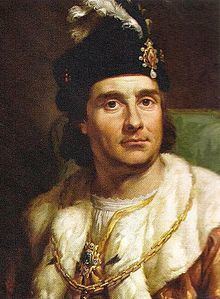Reign 1492–1501 Mother Elisabeth of Austria Name John Albert | Role King | |
 | ||
Born 27 December 1459Krakow, Poland ( 1459-12-27 ) Died June 17, 1501, Torun, Poland Parents Casimir IV Jagiellon, Elizabeth of Austria Siblings Sigismund I the Old, Alexander Jagiellon Grandparents Wladyslaw II Jagiello, Sophia of Halshany, Albert II of Germany, Elizabeth of Luxembourg Similar People | ||
John I Albert (Polish: Jan I Olbracht) (27 December 1459 – 17 June 1501) was King of Poland (1492–1501) and Duke of Głogów (1491–1498).
Contents
Early life and succession
John was the third son of Casimir IV, King of Poland, and Elisabeth, daughter of the elected king of Germany, King Albert of Hungary, Croatia and Bohemia, who died, when she was two years old. As the granddaughter of the late Emperor Sigismund, she was raised by Emperor Frederick III. As crown prince, John distinguished himself by his brilliant victory over the Tatars at Kopystrzyń (1487). In 1490, the Hungarian nobility proclaimed John King of Hungary at the Rákos diet. He was, however, defeated by his brother, King Vladislaus II of Hungary. In 1492, John succeeded his father as King of Poland thanks to the key intervention of his brother Friedrich Jagiellon, archbishop of Kraków and archbishop of Gniezno. Friedrich achieved the coronation of John. However, losses of revenue due to the secession of Lithuania placed John at the mercy of the Polish sejmiks, or local diets, where the szlachta, or local nobles, made their subsidies dependent on the king's subservience.
Plans against the Turks
John desired to pose as the champion of Christendom against the Ottoman Turks. Circumstances seemed, moreover, to favor him. In his brother Ladislaus, who as King of Hungary and Bohemia possessed a dominant influence in central Europe, he found a counterpoise to the machinations of Emperor Maximilian I, who in 1492 had concluded an alliance against him with Ivan III of Muscovy. As suzerain of Moldavia, John was favorably situated for attacking the Turks. At the conference of Leutschau (1494), the details of the expedition were arranged between the kings of Poland and Hungary and Elector John Cicero of Brandenburg, with the co-operation of Stephen III of Moldavia, hospodar of Moldavia, who had appealed to John for assistance.
In the course of 1496 John collected an army of 80,000 men in Poland with great difficulty, but the crusade was deflected from its course by the sudden invasion of Galicia by the hospodar, who apparently — for the whole subject is still very obscure — had been misled by reports from Hungary that John was bent upon placing his younger brother Sigismund on the throne of Moldavia. Whatever the reason, the Poles entered Moldavia not as friends but as foes, and after the abortive siege of Suceava were compelled to retreat following defeat at the Battle of the Cosmin Forest. The insubordination of the szlachta seems to have been one cause of this disgraceful collapse, for John after his return confiscated hundreds of their estates; in spite of which, to the end of his life he retained his extraordinary popularity.
Issues with Teutonic Knights and death
When the new Grand Master of the Teutonic Knights, Friedrich Wettin von Sachsen, refused to render homage to the Polish crown, John compelled him to do so. His intention to still further humiliate the Teutonic Order was stymied by his sudden death in 1501.
